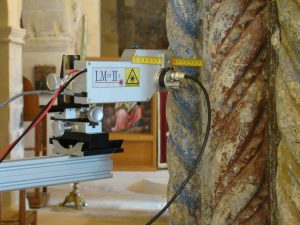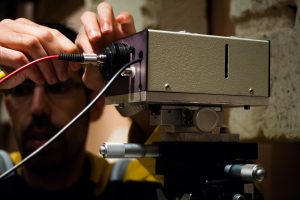Facility type: MOLAB
Access provider: Photonics for Heritage Science, IESL, FORTH
Title: Laser material analysis
Description
The researchers of IESL-FORTH, respond to the need for on-site material analysis with the development of portable or transportable instrumentation that has been optimized for in situ applications. A long list of related activities includes integrated analytical approaches applied in several field campaigns at museums and archaeological sites in Greece, Europe and the Middle East. The developed portable instrumentation includes:
- Laser Induced Breakdown Spectroscopy system
- Diffuse reflectance Spectroscopy
- micro-Raman Spectroscopy system,
Services
- Analysis and chemical characterization of materials in archaeological objects, artworks or historic monuments such as metals, stones, glass, paints and pigments, organic materials, etc.
- In-depth analysis of multilayered surfaces
- Investigation of degradation materials on different substrates
Technical Info
LNMT II, hybrid LIBS-Diffuse Reflectance Spectroscopy portable instrument
- Laser: nanosecond Nd-YAG 1064 nm
- Spectrometer : range 250-650nm, resolution 0.5nm
- Dimensions: Head: 20x10x3 cm -Control Unit: 26x25x9 cm -Spectrometer: 17x17x9 cm
- Weight: Less than 10 kg
- Viewing / aiming camera
- Build in spectral database for elemental identification
micro-Raman portable instrument
- Optical probe head: optics and filters, viewing camera, LED source (visible)
- Laser: cw diode laser (λexc: 785 nm)
- Spectrometer :
- grating spectrograph range 100-3300 cm-1, resolution 4-6 cm-1
- CCD detector
- Dimensions:
- optical probe head: 15.5x12x7.5 cm 3 ,
- laser: 13×9.5×4.5 cm 3 ,
- Spectrometer: 19×12.5×7 cm 3
- Total Weight: Less than 15 kg
Examples/Photos
|
|
|
Related Publications
- “Portable laser-induced breakdown spectroscopy/diffuse reflectance hybrid spectrometer for analysis of inorganic pigments”, P. Siozos, A. Philippidis, D. Anglos, Spectrochimica Acta Part B 137, 93-100 (2017); doi:10.1016/j.sab.2017.09.005.
- “A multi-technique approach, based on mobile/portable laser instruments, for the in-situ pigment characterization of stone sculptures on the island of Crete dating from Venetian and Ottoman period”, Z. E. Papliaka, A. Philippidis, P. Siozos, M. Vakondiou, K. Melessanaki, D. Anglos, submitted to the thematic series “Optical Technologies applied to Cultural Heritage” of ‘Heritage Science’ Journal, 4:15 (2015); doi: 10.1186/s40494-016-0085-2
- “Materials analyses of pyrotechnological objects from LBA Tiryns, Greece, by means of Laser-Induced Breakdown Spectroscopy (LIBS): Results and a critical assessment of the method” A. Brysbaert, P. Siozos, M. Vetters, A. Philippidis and D. Anglos, Journal of Archaeological Science 83, 49-61 (2017); doi:10.1016/j.jas.2017.06.007
- “Studying pigments on painted plaster in Minoan, Roman and Early Byzantine Crete. A multi-analytical technique approach”, P. Westlake, P. Siozos, A. Philippidis, C. Apostolaki, B. Derham, A. Terlixi, V. Perdikatsis, R. Jones, D. Anglos, Anal. Bioanal. Chemistry 402, 1413–1432, (2012); doi:10.1007/s00216-011-5281-z.


